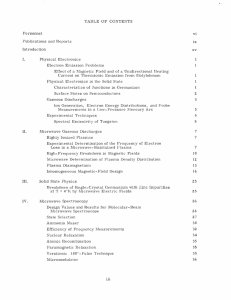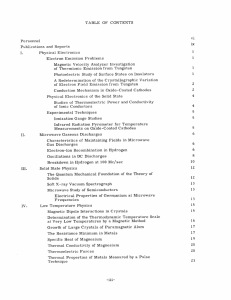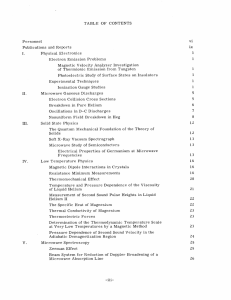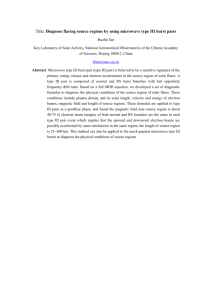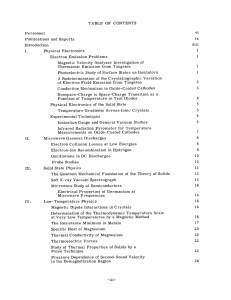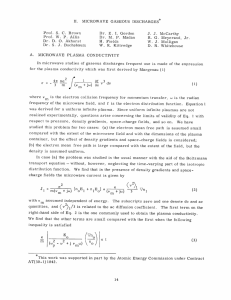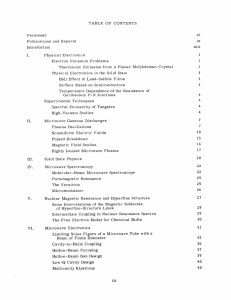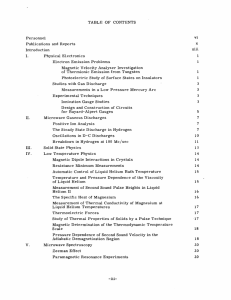II. MICROWAVE GASEOUS DISCHARGES
advertisement
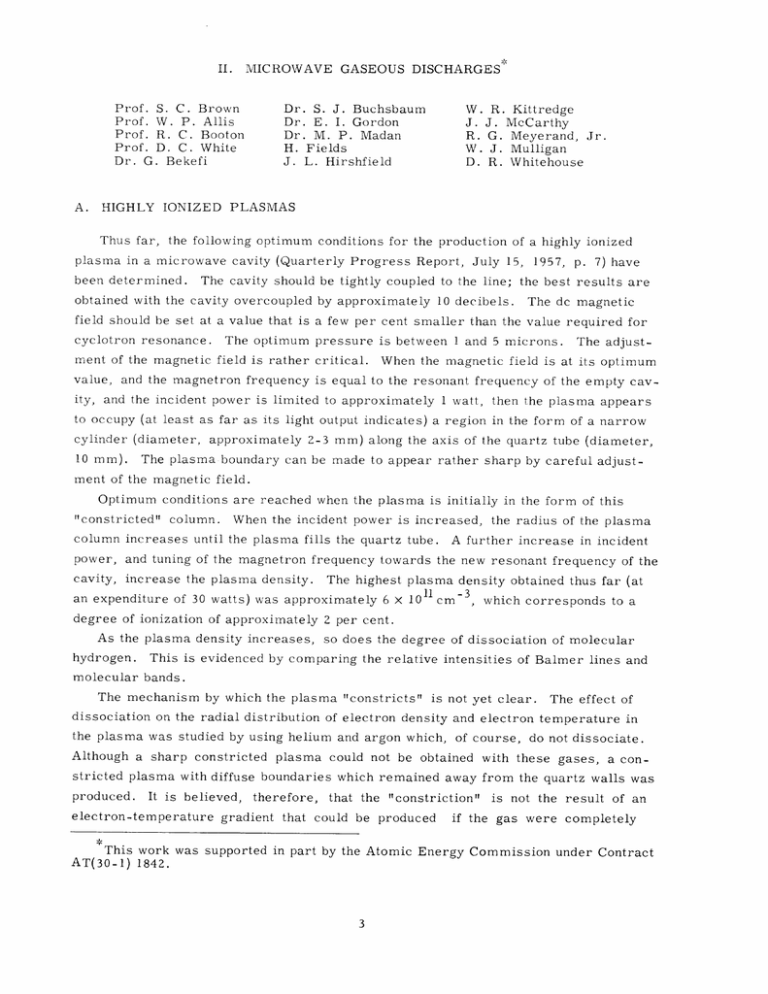
II. MICROWAVE Prof. S. C. Brown Prof. W. P. Allis Prof. R. C. Booton Prof. D. C. White Dr. G. Bekefi A. HIGHLY IONIZED GASEOUS DISCHARGES Dr. S. J. Buchsbaum Dr. E. I. Gordon Dr. M. P. Madan H. Fields J. L. Hirshfield W. J. R. W. D. R. J. G. J. R. Kittredge McCarthy Meyerand, Jr. Mulligan Whitehouse PLASMAS Thus far, the following optimum conditions for the production of a highly ionized plasma in a microwave cavity (Quarterly Progress Report, been determined. July 15, 1957, p. 7) have The cavity should be tightly coupled to the line; the best results are obtained with the cavity overcoupled by approximately 10 decibels. The dc magnetic field should be set at a value that is a few per cent smaller than the value required for cyclotron resonance. The optimum pressure is between 1 and 5 microns. ment of the magnetic field is rather critical. value, The adjust- When the magnetic field is at its optimum and the magnetron frequency is equal to the resonant frequency of the empty cav- ity, and the incident power is limited to approximately 1 watt, then the plasma appears to occupy (at least as far as its light output indicates) a region in the form of a narrow cylinder (diameter, approximately 2-3 mm) along the axis of the quartz tube (diameter, 10 mm). The plasma boundary can be made to appear rather sharp by careful adjustment of the magnetic field. Optimum conditions are reached when the plasma is initially in the form of this "constricted" column. When the incident power is increased, column increases until the plasma fills the quartz tube. the radius of the plasma A further increase in incident power, and tuning of the magnetron frequency towards the new resonant frequency of the cavity, increase the plasma density. The highest plasma density obtained thus far (at an expenditure of 30 watts) was approximately 6 X 1011 cm -3 , which corresponds to a degree of ionization of approximately 2 per cent. As the plasma density increases, so does the degree of dissociation of molecular hydrogen. This is evidenced by comparing the relative intensities of Balmer lines and molecular bands. The mechanism by which the plasma "constricts" is not yet clear. The effect of dissociation on the radial distribution of electron density and electron temperature in the plasma was studied by using helium and argon which, of course, do not dissociate. Although a sharp constricted plasma could not be obtained with these gases, a con- stricted plasma with diffuse boundaries which remained away from the quartz walls was produced. It is believed, electron-temperature therefore, that the "constriction" gradient that could be produced is not the result of an if the gas were completely This work was supported in part by the Atomic Energy Commission under Contract AT(30-1) 1842. (II. MICROWAVE GASEOUS DISCHARGES) dissociated in the inner core, molecular hydrogen were forming by recombination on the radial walls, and upon streaming back towards the axis of the tube, it were disso- ciated again with the result that the electron cloud in the immediate neighborhood of the quartz wall is cooled. Experiments are in progress to determine the role which the radial walls of the quartz tube play in the production of the constricted plasma. When the tube radius is reduced one-half (0.5 cm), the constricted plasma is no longer in the form of a uniform cylinder but is in the form of a cylinder whose diameter decreases as the distance from the central plane increases. perhaps, The plasma appears like an elongated football, suggesting, that most of the plasma electrons are produced near the center of the tube, and, as a result of the decreased radius of the quartz tube, some of the electrons are lost in the radial direction as they move along the B-field lines toward the end walls. More experiments are planned in order to determine the mechanism of the "constricted" plasma. We believe that the phenomenon is important, only when the plasma is in the "constricted" since it appears that state can high densities be produced. S. J. B. Buchsbaum PLASMA DIAMAGNETISM It was shown in a previous report (1) that if we consider only the diffusion and mobil- ity currents in a quasi-static plasma, the relationship between the plasma density n(r), the electron and ion temperatures T_ and T+, and the magnetic field B(r) is given by -onk in which + T ) I+_ in= (T and + 1 (B - BZ (1) _ _ are the ion and electron mobilities in the absence of magnetic fields. = 1 -6B/B Writing B/B B/B o, we can plot 6B/B as a function of - + T ) 4i. +nk(T with For nk(T+ + T_) <(1/5)BZ /2 jo' 1+ B2 as a parameter. This is shown in Fig. II-1. that is, with the plasma pressure less than the magnetic pressure, a very good approximation to Eq. 1 can be written as 2 B2 B+ 6B 1+ + 2 Bo o nk(T+ + T ) B o (2) Steenbeck (2) has measured the change in the magnetic field as a result of the plasma diamagnetism by superimposing a sinusoidal electron-density modulation upon the steadystate density distribution and measuring the sinusoidal component of the magneticfield strength. Figure 11-2 shows the curve of Eq. -1 -3 -4 yields nkT = 1.3 X 10 erg-cm , +¢ = 4 X 10 2 fitted to his data. -2 gauss This fit at a pressure of 3 microns. 10 10 2 I01 10 Fig. II- 1. LL +T_ )+ Lonk (T Relative change in field strength as a function of ion pressure. Dashed lines refer to Eq. 2. 16 3 I I 100 120 -0.2 -0.4 20 40 60 80 140 160 180 200 H (OERSTED Fig. II-2. Change in magnetic-field strength as a function of applied field strength. (II. MICROWAVE GASEOUS DISCHARGES) Converting to more conventional units, volts- we obtain ([ p) (L p) = 3.6 X 107 cm 4 -sec-2 -(mm Hg) . For mercury, Aisenberg (3) gives _p = 1.49 X 105( e )'/2 (3) +p = 3.05 x 103(E/p)-1/2 If we assume as appropriate values for Steenbeck's discharge kT/e = 1.5 volts and E/p = 100 volts/cm mm Hg, Eq. 3 yields ( p) ( For the varying part of Steenbeck's density, p) = 3. 72 X 107 we can assume that n = 5 X 10 -1 within one order of magnitude. 10 cm -3 -3 This yields nkT = 1.2 X 10 erg cm . The very good agreement in both mobility and density is probably accidental, but it does indicate that Eq. 2 may be valid. Steenbeck's measurements were made in the positive column of a mercury arc. Our present experiments are directed toward observing the diamagnetism in a microwave maintained discharge. E. I. Gordon References 1. Quarterly Progress Report, Research Laboratory of Electronics, M.I.T., July 15, 1957, p. 14, cf. Eq. 7. 2. M. Steenbeck, Uber die magnetischen Eigenschaften des Plasmas von Gasentladungen, Wiss. Veroff. Siemens-Werken 15, 2, 1 (1936). 3. S. Aisenberg, Ph.D. Thesis, Department of Physics, M.I.T., C. MEASUREMENTS OF ELECTRON COLLISION PROBABILITIES IN GASES June 1957. Measurements of the electron collision probability for momentum transfer in hydrogen with the use of techniques described elsewhere (1) are in progress. At present, results are available only for the case in which the electrons are in thermal equilibrium with the gas at room temperature. The means of determining electron collision probability consists, essentially, of measuring the conductivity in the afterglow of a microwave discharge. In the absence of inelastic collisions, the complex radiofrequency conductivity G- is given by - rne o (v/w 3 dv (1) where v is the electron velocity, e and m are the electronic charge and mass, w is the angular frequency of the rf field, f is the electron velocity distribution function, and (II. GASEOUS DISCHARGES) MICROWAVE 0.025 -\0 -I 0.024 0.0230.0220.021 0.0200.019 0.02 0.01 0.04 0.07 0.1 0.2 0.4 0.7 1.0 2.0 4.0 Conductivity ratio in the afterglow of a hydrogen plasma as a function of pressure. Fig. 11-3. n is the electron density. The collision probability Pm is related to the collision fre- quency v through V = PmPo v where po is the gas pressure normalized to O0 C. Measurements approximately quantity a-r/Po were carried out in hydrogen over a range of pressures p 0.5 to 100 mm Hg. The results are shown in Fig. r/-i', is plotted against 11-3, in which the the latter being an indirect measure of the pres- sure at which the measurement was made. Each experimental point shown represents an average of five or more readings taken at various times in the afterglow, a range from 100 4sec to 12 msec. from covering Within this interval the conductivity ratio was quite independent of the time. The collision probability Pm is determined by comparing the experimental results of Fig. II-3 with predictions from Eq. reasonable velocity dependence, 1. This is achieved by postulating for v a preferably in the form of a power series, and then fitting the coefficients to the experimental curve. In view of the difficulties of evaluating the ensuing integrals at any pressures except low pressures (v/w << 1), workers in the field have assumed the following simple power law: v = apov h (2) (II. MICROWAVE GASEOUS DISCHARGES) If we make a substitution from Eq. 00 1.5+0.5h 2h dx e 1, we obtain 1.5 e x x 1 l+yx 0 1 2 in Eq. x2h dx (3) l-tyx with y = (2kT/m)h/2 apo/, where k is Boltzmann's constant, and T is the absolute temperature of the gas. The best fit between experiment and Varnerin's (2) numerical solution of Eq. 3 is found for the case h = 1.6 (see Fig. 11-3), which yields the following value for the collision probability P = 28(v/v) 0 . 6 cm-1 mm-1 Hg; V = 0.161(volt)1/2 where v is the most probable velocity at a temperature of 3000 K. This value of P m differs greatly from that of Phelps, Fundingsland, and Brown (3), who quote a value of 46, subject to the assumption that Pm is independent of velocity, but it is in substantial agreement with Varnerin's (2, 4) value, P ~ 34(v/v) 0 6 m Table II-1. Error in r/- i Number of Terms of Series 2% 0 h 1.0 0 h 1.0 1 <h <1.6 first term only for 0 < y < 1 < 5o for 1 < y 1. 5 first two terms < 3% 1.6 <h < 2 for 0 first term only y < 1 for 7 for 0 < y first two terms 1 As we have mentioned, in those cases for which it is not desirable to satisfy the condition v/w << 1, the conductivity integral must, in general, be evaluated numerically. Moreover, the complexity increases manyfold if the distribution function departs from Maxwellian or if the plasma is acted upon by a magnetic field. Approximate solutions were sought and good results were obtained with the aid of a recently derived (5) asymptotic solution of the integral e -px 0 c-1 F(x) dx= p- '(c) c(c+ 1) . k=O (c + k 1) p- 2 k F k MICROWAVE GASEOUS DISCHARGES) (II. where (x) Fo(x) = F(x) ;F d Fk(X) - Fk-Pj) x and p must be " sufficiently"' p large and may be complex; Re c > 0, and F(x) is an ana- lytic function. For example, in applying this expansion to the evaluation of Eq. 3, we set p = 1, 2h -1 , and c = 2.5 + 0.5h or c = 2.5, depending upon which of the two F(x) = (1 + y2xh) integrals is being evaluated. Table II-1 shows the degree of accuracy attainable with the asymptotic formula as compared with a numerical evaluation of the integrals. G. Bekefi References Brown, Phys. Rev. 95, 897 (1954). 1. L. Gould and S. C. 2. L. J. Varnerin, Jr., Progress Report CR31-555-21, Inc., Boston, Massachusetts, 1951. 3. A. V. 4. L. J. 5. J. Franklin and B. Friedman, Research Report No. BR-9, cal Sciences, New York University, 1954. D. Phelps, O. T. Varnerin, Jr., Fundingsland, and S. C. Phys. Rev. 84, Sylvania Electric Products, Brown, Phys. Rev. 84, 559 (1951). 563 (1951). Institute of Mathemati- HIGH-CURRENT ION SOURCE The design and initial testing of an ion source capable of producing a 20-ma beam of hydrogen ions at an energy of approximately 500 volts have been completed. A magnetic field was used to focus the beam, and to maintain the discharge at a pressure of approximately one micron. Differential pumping was employed to reduce the pres- sure in the accelerating section of the ion source. The electrode configuration in the ion source is shown in Fig. 11-4. modeled after a device built by F. M. Penning and J. H. A. Moubis (1). The source was The cathode is a pure tungsten ribbon, 0.001 inch thick, with an emitting surface approximately 0.25 inch square. It is heated to electron-emission temperatures by an ac heating unit. The electrodes are constructed of nonmagnetic molybdenum, temperatures in a hydrogen atmosphere. and can operate at high The accelerating electrode draws electrons from the hot cathode but cannot collect them because the magnetic field prevents their reaching the accelerating electrode. potential as the cathode, The deaccelerating electrode, which is at the same stops the electrons and returns them in the direction toward (II. MICROWAVE GASEOUS DISCHARGES) MAGNETIC FIELD OUT OF PAPER MAGNETIC FIELD CATHODE TO -- PUPS -- ACCELERATING ELECTRODE (+3KV) ION BEAM 1'/"i TRAPPED iELECTRONS I I DEACCELERATING ELECTRODE Fig. 11-4. SUPPLY CATHODE (GROUND) END VIEW TO H 2 (GROUND) SIDE VIEW Electrode configuration in the ion source. the cathode. The electrons perform many oscillations in this manner, until they are eventually lost to the accelerating electrode through collisions with hydrogen atoms. Thus a single electron can make many ionizing collisions in its lifetime; only a reasonable electron current need be emitted from the cathode to produce a large ion current. For ions produced in the source, the functions of the electrodes are reversed, since the "trapping" action works only for negatively charged particles. The positively charged ions are accelerated toward the ground potential of the deaccelerating electrode and leave the source as a beam. A steady magnetic field of approximately 800 gauss is produced by an external solenoid, and serves the dual purpose of trapping the electrons and preventing the spread of the ion beam which is caused by space charge. R. G. Meyerand, Jr. References 1. E. F. M. Penning and J. H. A. Moubis, Eine Neutronenr6hre ohne Pumpvorrichtung, Physica 4, 1190 (1937). PULSE BREAKDOWN IN A MAGNETIC FIELD By observing the rate of increase of electron density in a microwave discharge, it is possible to study quantitatively some of the processes that lead to the gain of electrons in the plasma, and also the interdependence of various parameters involved in these processes. The rate of growth of electron density can be written generally as aN at (vi - L)N (1) (II. where v i is the frequency of electron production, electron loss. MICROWAVE GASEOUS DISCHARGES) and vL represents the frequency of Equation 1 shows that a measurement of time for the build-up of elec- tron density to a value that is large enough to be detected yields information about the net electron gain, whereas a similar measurement when the plasma is decaying (v will give information about v L i = 0) Determinations of frequency of ionization and coefficient . of diffusion, by using a pulsed microwave discharge, in the absence of a magnetic field, In the present report an analogous technique for have already been reported (1, 2). studying the behavior of a microwave pulsed discharge in the presence of a magnetic field is described. The experimental arrangement (1) is nearly the same as that used before, except that the plasma is now produced in a narrow cylindrical tube, which is placed along the placed in axis of a cylindrical microwave cavity (TE111 mode). The quartz tube is a static magnetic field parallel to the axis of the tube. The principle of cyclotron reso- nance is utilized as an efficient means of energy transfer from the microwave field to -4 -3 mm Hg. -10 the electron, and the working pressures are of the order of 10 Preliminary measurements indicated that with the application of a microwave pulse, the breakdown of 4.84 WATTS 5-B= CONSTANT 7. 44 the gas takes place erratically. SBCONSTANT b There- 11.2 fore, in order to reduce the statistical 4- lag, a low-density plasma is main3 tained with a low-power cw signal, then the density of the plasma in the 2 quartz tube is increased by a microwave pulse. The time for the build-up of the electron density to a value Nm, 0.i Fig. 11-5. 0 3 0.2 0 4 0.5 taken as the number of electrons that /p. Breakdown time against 1/p with input power as a parameter, for a constant magnetic field. causes the electric field in the cavity to decrease 5 per cent (1), is measured with the aid of a Tektronix oscilloscope as a function of the power level in the microwave pulse and as a function of the static magnetic field close to the value that corresponds to cyclotron resonance. Time for breakdown is minimum when the cyclotron frequency wb equals the microwave frequency o. It also decreases when the input microwave power is increased. Figure II-5 shows that at a constant value of input power and of the magnetic field the time for breakdown varies inversely with pressure. That this should be so can be seen from Eq. 1, in which the total number of electrons is written as (II. MICROWAVE GASEOUS DISCHARGES) No exp(vi - vL)t N (2) or 1 (vi -L) t In N (3) (3) N To a first approximation we can assume that vL is small, and write 1 t N I In N hv N 1 c o 1 In h. 5.9 X 10 p 1 N N 4) (4) o The slope of the lines in Fig. 11-5 yields only qualitative information about the probability of ionization per collision, h., since both N and N 1 O are unknown. But let us assume B= 1175 B= 116 4- 3X B= 113 2- 11.2 WATTS SP= 0 0.1 0.2 0.3 0.4 0.5 I/p Fig. 11-6. Breakdown time against 1/p with magnetic field (in relaative units) as a parameter, for constant input power. that the density builds up over, Fig. II1-5, we obtain h i - 0. 7, say, two orders of magnitude. which is reasonable. Then, from curve a in In Fig. II-6 similar curves (i.e., t against 1/p with magnetic field as a parameter) for a constant input power are plotted. These two plots show that the changes in slope are small as the input power is increased, whereas the changes in slope are large as the magnetic field is varied. This behavior of the curves indicates that large changes in the electron energy take place as the magnetic field is varied over a small region close to its cyclotron-resonance value. M. P. Madan References 1. M. P. Madan, E. I. Gordon, S. J. Buchsbaum, and S. C. Brown, Determination of the coefficient of diffusion and frequency of ionization in microwave discharges, Phys. Rev. 106, 839 (1957). 2. M. P. Madan, Microwave determinations of frequency of ionization and coefficient of free diffusion, Quarterly Progress Report, Research Laboratory of Electronics, Oct. 15, 1956, p. 15.
